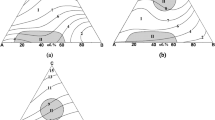Abstract
The morphology and microstructure of the Pb1−xSnxTe surfaces polished by the H2O2–HBr–ethylene glycol etchants have been investigated using atomic force and electron microscopy techniques. Treatment of the Pb0.8Sn0.2Te crystal surfaces with new etchant mixtures allows to obtain ultra-smooth surfaces Ra < 1 nm. The single crystal surfaces after chemical–mechanical and chemical-dynamic polishing by the bromine emerging compositions has been studied using metallography and profilometry. The structural perfection and chemical composition of the Pb1−xSnxTe surfaces polished by the chemical treatment have been determined by X-ray analysis, scanning electron microscopy, and Raman spectroscopy.




Similar content being viewed by others
References
Aleksandrova OA, Moshnikov VA (2007) Physics and chemistry of optoelectronic and nanoelectronic materials: a practical course. SPbGETU LETI, St. Petersburg (in Russian)
Anufriev LP et al (2009) Integrated electronics technology. Integralpoligraph Publ., Minsk (in Russian)
Apte A et al (2019) Polytypism in ultrathin tellurium. 2D Mater 6(1):015013
Bochkin OI et al (1983) Mechanical treatment of semiconductor materials. Vysshaya Shkola Publ., Moscow (in Russian)
Khokhlov DR et al (2000) Performance and spectral response of Pb1−xSnxTe(In) far-infrared photodetectors. Appl Phys Lett 76(20):2835–2837
Malanych GP et al (2017) The influence of ethylene glycol on the chemical interaction of PbTe and Pb1−xSnxTe crystals with H2O2–HBr–ethylene glycol etching compositions. Semicond Phys Quant Electron Optoelectron 20(1):91–95. https://doi.org/10.15407/spqeo20.01.091
Osipova EV et al (1991) The investigation of damaged layers on the surface of lead telluride single crystals after different methods of cutting [in Russian]. Neorgan Mater 27(6):1200–1203
Pop SS, Sharodi IS (2001) Physical electronics. Euroworld, Lviv (in Ukrainian)
Shperun VM et al (2000) Thermoelectric properties of lead telluride and its analogs. Ivano-Frankivsk, Plai (in Ukrainian)
Smirnov M et al (2018) Raman spectra and structural peculiarities of TeO2–TeO3 mixed oxides. J Phys Condens Matter 30(47):475403
Tomashyk ZF et al (2012) Polishing of PbTe and Pb1−xSnxTe single crystals with H2O2–HBr–ethylene glycol bromine-releasing etchants [in Ukrainian]. Voprosy khimii i khim tekhnologii 4:120–125
Author information
Authors and Affiliations
Corresponding author
Ethics declarations
Conflict of interest
The authors declare that they have no competing interests.
Additional information
Publisher’s Note
Springer Nature remains neutral with regard to jurisdictional claims in published maps and institutional affiliations.
Rights and permissions
About this article
Cite this article
Malanych, G.P., Kolomys, O.F., Korchovyi, A.A. et al. Atomic force microscopy and Raman spectroscopy of Pb1−xSnxTe surfaces polished after treatment with H2O2–HBr–ethylene glycol etchants. Appl Nanosci 10, 2717–2722 (2020). https://doi.org/10.1007/s13204-019-00974-x
Received:
Accepted:
Published:
Issue Date:
DOI: https://doi.org/10.1007/s13204-019-00974-x




